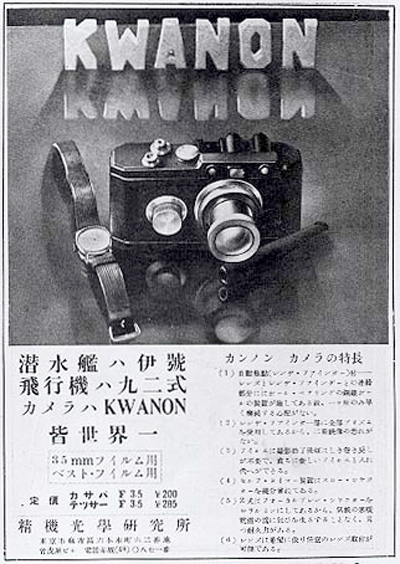|
Kwanon Prototype Camera, numbered 2 on inside of
the body and on the base plate, black paint, with nickel-plated fittings,
pop-up viewfinder, shutter speeds 2, 25, 40, 60, 100, 200, 500,
rewind knob, exposure counter on the front, central tripod bush on the base
plate, and un-numbered screw-fit KasyaPa
f/3.5 50 mm. lens in nickel-plated mount, (brassing
on the edges, optics cracked, shutter defective, mechanical condition and
completeness not guaranteed).
Provenance: From information supplied by the consignor, the camera was
acquired ten years ago from the daughter of a real estate agent in the Bronx, New York, along with a Contax I and a Leica II, who
reported that all three cameras had been in the family since the early
1950s.
Note: The Kwanon is the earliest, pre-production
form of the Canon camera. Its designer, GoroYoshida,
was born in Hiroshima in 1900 and spent his early career
repairing and modifying motion picture cameras and projection equipment, with
trips to Shanghai in the late 1920s to procure parts.
His skills, combined with the perception that the Leica
and Contax Model I were "takane
no hana" (beyond the reach) of most people,
inspired Yoshida to design the first quality Japanese 35 mm. camera.
Yoshida's task was made more difficult by the fact that, before 1945, Leitz held all of the major patents for 35 mm. camera
production. The LeicaĂs patented coupled
rangefinder and viewfinder under one roof presented a particular problem.
As Zeiss discovered with the Contax,
anyone wishing to market a new 35 mm. camera, had to come up with a
completely new design that was different from the Leica.
(After the war, with Germany defeated, this was no longer a
problem). However, Yoshida did dismantle a Leica
for inspiration, reporting that" I just dissasembled
the camera without any specific plan, but simply to take a look at each
part. I found that there were no special items like diamonds inside the
camera. The parts were made from brass, aluminum, iron and rubber."
With this in mind, Yoshida enlisted the financial backing of his
brother-in-law, Saburu Ochida,
and formed Seiki-Kogaku (which became the
Precision Optical Works) in 1933 for the development of his idea. He named
his prototype "Kwanon" after the
Buddhist Goddess of Mercy, and the lens "Kasyapa" after one of Buddha's disciples.
Although Yoshida claimed to have completed ten Kwanon
cameras, the camera was apparently never put on the market, although not
through want of advertising. A picture in the June 1934 issue of Asahi
Camera magazine showed a black 35 mm. camera, with elements from both the Leica and the Contax, and the
enthusiastic claim that ˘the best submarine is
the Igo. The best airplane is the Model 92. The
best camera is the Kwanon. They are all the best
in the world÷. Although three variations of the Kwanon were advertised, all were apparently
non-functional wooden dummies, which varied from advert to advert. This may
have been because Yoshida was ultimately unable to circumvent Leica's rangefinder-coupling patents; he was
subsequently "fired" from Seiki Kogaku
in 1934, and apparently played no subsequent part in the development of the
Kwanon.
In 1934, Seiki Kogaku approached Nippon Kogaku, the largest manufacturer of optics in Japan, in the hope of finding a method
of rangefinder coupling that would avoid the Leica
patents on this feature. Eiichi Yamanaka was the Nippon Kogaku
technician who was primarily responsible for developing what became the new
Hansa lens-mount; by contrast, the Kwanon here still retains a disc and lever assembly
that couples with the lens Leica-style. With
Nippon Kogaku supplying the optical system and
Seiki Kogaku responsible for the chassis, the new
design was ready for production before the end of 1935. The name was
changed from ˘Kwanon÷ to ˘Canon÷,
and the resulting design ű designated the ˘Hansa Canon÷ after the trademark of its retailer, the Omiya Shashin Yohin Co. ű was the first true production Canon camera.
Thanks in part to their experience with the Hansa
and the Kwanon, Nippon Kogaku
introduced their own first 35 mm. camera, the Nikon I, in 1948. The leagcy of this landmark collaboration was the
development of both Canon and Nikon into the two largest camera
manufacturers today.
As Seiki-Kogaku had already planned for the
production of the Kwanon, spare Kwanon parts (such as the base plate with centered
tripod bush) that were in stock may have been used on the early Hansa Canon models. There is a story that only one
actual Kwanon camera was finally sold, in a Tokyo
camera store .The incorporation of a folding viewfinder on the top plate,
the advance / rewind knob (which does not appear in the advertised cameras)
and the spindle-disengagement were the semi-final modifications of the Kwanon's body design, and suggest that the camera here
probably dates from late 1934 or early 1935. . The number "2"
stamped into the inner surface of the base plate raises the possibility
that this is the second operable Kwanon made, and
possibly the only on to have survived. Thanks to Peter Dechert
for his assistance in researching the catalogue notes.
|

![]()
 á
á á
á á
á á
á á
á á
á á
á á
á




